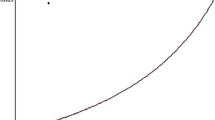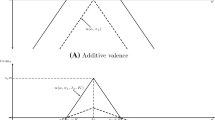Abstract
We construct a spatial election model in which candidates inherit initial positions in the strategy space, presumably from previous political activity, and they are restricted to strategies close to their initial positions. We establish sufficient conditions for the existence of an equilibrium. The equilibrium need not entail an expectation of a zero plurality for each candidate. We then apply this model to a sequence of elections in which a series of opposition candidates challenge incumbents. Given certain regularity conditions, the result will be an apparent incumbency advantage, corresponding to that observed in recent congressional elections.
Similar content being viewed by others
REFERENCES
Abramowitz, A.I. (1980). A comparison of voting for U.S. senator and representative in 1978. American Political Science Review 74(3): 633–640.
Aranson, P.H., Hinich, M.J., and Ordeshook, P.C. (1974). Election goals and strategies: Equivalent and nonequivalent candidate objectives. American Political Science Review 68(1): 135–152.
Aranson, P.H., and Ordeshook, P.C. (1972). Spatial strategies for sequential elections. In R.G. Niemi and H.F. Weisberg (Eds.), Probability models of collective decision making, 298–331. Columbus, Ohio: Merrill.
Born, R. (1979). Generational replacement and the growth of incumbent safety margins in the U.S. House. American Political Science Review 73(3): 811–817.
Brams, S.J., and Straffin, P.D. Jr. (1982). The Entry problem in a political race. In P.C. Ordeshook and K.A. Shepsle (Eds.), Political equilibrium, 181–196. Boston: Kluwer-Nijhoff.
Burnham, W.D. (1974). Communications. American Political Science Review 68(1): 207–211.
Burrill, C.W. (1972). Measure, integration, and probability. New York: McGraw-Hill.
Cohen, L., and Matthews, S. (1980). Constrained Plott equilibria, directional equilibria and global cycling sets. Review of Economic Studies 47(5): 975–986.
Coleman, J.S. (1972). The positions of political parties in elections. In R.G. Niemi and H.F. Weisberg (Eds.), Probability models of collective decision making, 332–357. Columbus, Ohio: Merrill.
Collie, M.P. (1981). Incumbency, electoral safety, and turnover in the House of Representatives. American Political Science Review 75(1): 119–131.
Comaner, W.S. (1976). The median voter rule and the theory of political choice. Journal of Public Economics 5(1–2): 169–177.
Coughlin, P., and Nitzan, S. (1981a). Electoral outcomes with probabilistic voting and Nash social welfare maxima. Journal of Public Economics 15(1): 113–121.
Coughlin, P., and Nitzan, S. (1981b). Directional and local electoral equilibria with probabilistic voting. Journal of Economic Theory 24(2): 226–239.
Cover, A.D. (1977). One good term deserves another: The advantage of incumbency in congressional elections. American Journal of Political Science 21(3): 523–541.
Davis, O.A., and Hinich, M.J. (1972). Spatial competition under constrained choice. In R.G. Niemi and H.F. Weisberg (Eds.), Probability models of collective decision making, 358–377. Columbus, Ohio: Merrill.
Davis, O.A., Hinich, M.J., and Ordeshook, P.C. (1970). An expository development of a mathematical model of the electoral process. American Political Science Review 64(2): 426–448.
Denzau, A.T., and Kats, A. (1977). Expected plurality voting equilibrium and social choice functions. Review of Economic Studies 44(2): 227–233.
Erikson, R.S. (1972). Malapportionment, gerrymandering, and party fortunes in congressional elections. American Political Science Review 64(4): 1234–1255.
Ferejohn, J.A. (1977). On the decline of competition in congressional elections. American Political Science Review 71(1): 166–176.
Fiorina, M.P. (1977). The case of the vanishing marginals: The bureaucracy did it. American Political Science Review 71(1): 177–181.
Hinckley, B. (1980a). The American voter in congressional elections. American Political Science Review 74(3): 641–650.
Hinckley, B. (1980b). House reelections and Senate defeats: The role of the challenger. British Journal of Political Science 10(4): 441–460.
Hinich, M.J. (1977). Equilibrium in spatial voting: The median voter result is an artifact. Journal of Economic Theory 16(2): 208–219.
Hinich, M.J., Ledyard, J.O., and Ordeshook, P.C. (1972). Nonvoting and the existence of equilibrium under majority rule. Journal of Economic Theory 4(2): 144–153.
Hinich, M.J., Ledyard, J.O., and Ordeshook, P.C. (1973). A theory of electoral equilibrium: A spatial analysis based on the theory of games. Journal of Politics 35(1): 154–193.
Hinich, M.J., and Ordeshook, P.C. (1969). Abstention and equilibrium in the electoral process. Public Choice 7 (Spring): 81–106.
Intriligator, M.D. (1973). A probabilistic model of social choice. Review of Economic Studies 40(4): 553–560.
Kramer, G.H., and Klevorick, A.K. (1974). Existence of a ‘local’ co-operative equilibrium in a class of voting games. Review of Economic Studies 41(4): 543–547.
Luce, R.D. (1959). Individual choice behavior. New York: Wiley.
Mann, T.E. (1978). Unsafe at any margin; Interpreting congressional elections. Washington: American Enterprise Institute for Public Policy Research.
Mann, T.E., and Wolfinger, R.E. (1980). Candidates and parties in congressional elections. American Political Science Review 74(3): 617–632.
Matthews, S.A. (1979). A simple direction model of electoral competition. Public Choice 34(2): 141–156.
Mayhew, D.R. (1974). Congressional elections: The case of the vanishing marginals. Polity 6(3): 295–317.
McKelvey, R.D. (1975). Policy related voting and electoral equilibrium. Econometrica 43(5–6): 815–843.
Plott, C.R. (1967). A notion of equilibrium and its possibility under majority rule. American Economic Review 57(4): 787–806.
Riker, W. (1962). The theory of political coalitions. New Haven: Yale University Press.
Riker, W., and Ordeshook, P.C. (1973). An introduction to positive political theory. Englewood Cliffs, N.J.: Prentice-Hall.
Tufte, E.R. (1973). The relationship between seats and votes in twoparty systems. American Political Science Review 67(2): 540–554.
Uslander, E.M. (1981). The case of the vanishing liberal senators: The house did it. British Journal of Political Science 11(1): 105–113.
Wittman, D.A. (1973). Parties as utility maximizers. American Political Science Review 67(2): 490–498.
Author information
Authors and Affiliations
Additional information
The helpful comments of Peter Aranson and three anonymous referees are gratefully acknowledged. Errors remain the author's responsibility.
Rights and permissions
About this article
Cite this article
Samuelson, L. Electoral equilibria with restricted strategies. Public Choice 43, 307–327 (1984). https://doi.org/10.1007/BF00118939
Published:
Issue Date:
DOI: https://doi.org/10.1007/BF00118939




